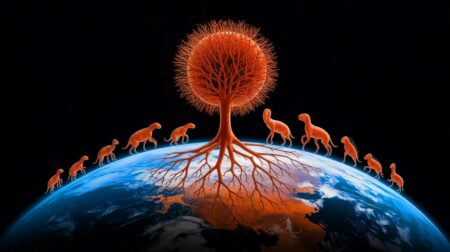The relentless loss of wildlife species and a fast-changing climate are two of the gravest planetary challenges, but by alleviating one we can mitigate the other, scientists say.
By restoring wildlife populations across the planet we can boost natural carbon capture and storage through “supercharging ecosystem carbon sinks,” according to an international team of experts.
The 15 scientists from eight countries found that restoring the populations of nine species of wildlife on land and in water (fish, whales, sharks, grey wolves, wildebeest, sea otters, musk oxen, African forest elephants, and American bison) could yield an extra 6.41 billion tons of carbon dioxide in carbon capture each year.
“This is 95% of the amount needed every year to meet the Paris Agreement target of removing enough carbon from the atmosphere to keep global warming below the 1.5-degree Celsius threshold,” they note.
“Wildlife species, throughout their interaction with the environment, are the missing link between biodiversity and climate,” says Oswald Schmitz, a professor at the Yale School of the Environment who led the study. “This interaction means rewilding can be among the best nature-based climate solutions available to humankind.”
Wild animals play a crucial role in controlling the planet’s carbon cycle across a variety of ecosystems through foraging, depositing nutrients and organic carbon, dispering seeds and other functions, according to the experts.
Other endangered species with high potentials for carbon capture and storage include African buffalo, white rhino, puma, dingo, primates, hornbills, fruit bats, seals, sea turtles, the scientists say.
“The dynamics of carbon uptake and storage fundamentally changes with the presence or absence of animals. Endangering animal populations to the point where they become extinct could flip the ecosystems they inhabit from carbon sinks to carbon sources,” the scientists explain.
Currently, the planet is facing a mass extinction of wildife species with global wildlife populations having declined by almost 70% in the past half century.
Both this ongoing mass extinction and climate change are being driven primarily by human activities, and this study throws fresh light on how restoring critically endangered animals can also help us manage climate change by enhancing natural carbon capture and storage through large-scale rewilding.
“Natural climate solutions are becoming fundamental to achieve the goals of the Paris Climate Agreement, while creating added opportunity to enhance biodiversity conservation,” the authors write.
“We call for new thinking that includes the restoration and conservation of wild animals and their ecosystem roles as a key component of natural climate solutions that can enhance the ability to prevent climate warming beyond 1.5 °C.”
Did you like it? 4.5/5 (23)








